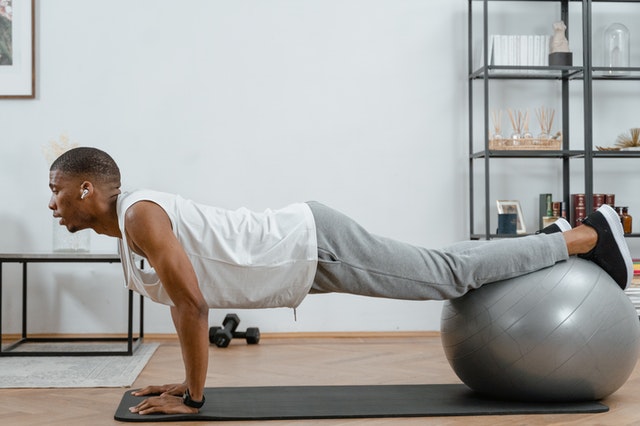Intense workouts are a key part of improving your fitness. Pushing your physical limits helps you feel strong. When you experience a surge of endorphins, your energy and positivity soar.
Waking up the next day with pain and stiffness is another story. While you have certainly been successful in your workout, you haven’t taken the right steps towards good recovery.
What should I do after a workout?
Just as important as training is what you will do over the next 24 hours to help your body recover. This is the stage in which muscles rebuild and strengthen, and where you prepare for your next workout.
If you don’t have the time or the patience to cover all of the recovery steps, even a few will help you make a difference. Here are eight steps you can take to improve your post-workout recovery.
1. Good hydration: Heavy workouts can cause heavy sweating. It’s important to start preparing for it before you even start your workout. Experts recommend drinking 6 mL of water per kg of body weight every two to three hours before training to make sure you start your workout well hydrated.
You should also start rehydrating soon after finishing your workout to help replace fluids lost through sweating. To find out how much fluid you have lost, weigh yourself before and after exercise.
If you’ve been sweating for more than an hour, you should also replenish the sodium lost through sweating by drinking an electrolyte drink or adding 0.5-0.7 g / L of sodium to your water bottle.
Water will usually be sufficient to rehydrate you after a moderate workout. To quench your thirst after a long or intense effort, choose something that also contains electrolytes, for example:
- Coconut water for a natural source of potassium, sodium and magnesium
- Iced green tea with ¼ tsp. teaspoon salt per 1000 mL
- A half and half mixture of fresh fruit juice and water
- A homemade sports drink made from 1000 mL of water, fresh lemon juice, 1 Tbsp. of honey and ¼ tsp.
2. A snack after training :
An intense workout depletes much of the glycogen and amino acids stored in your body. Having a snack within 30 minutes of your workout can go a long way for your recovery. This period is considered crucial for the replenishment of energy and nutrient reserves necessary for the reconstruction of muscle fibers.
A snack that contains a 3: 1 ratio of carbohydrates and protein is considered the best option to support muscle protein synthesis. Here are some satisfying post-workout snacks that are easy to fit into a busy schedule or even eat on the go:
A fresh fruit smoothie that will help replenish fluids while providing protein and carbohydrates.
A toast of whole grain bread spread with almond butter
A protein shake powered by Whey Factors that contains 17g of undenatured whey protein per serving from pasture-fed animals to help build and maintain lean muscle mass
- Canned salmon on whole grain crackers
- Pita bread and hummus
- Greek yogurt and berries
- A banana
3. Supplements for recovery:
No matter how nutritious your diet is, there may be times when the extra support of a supplement will have its benefits. Some effective solutions to aid recovery include:
L-glutamine: an amino acid that helps repair muscle cells after exercise. Optimizing Recovery & Muscle Growth brings together micronized L-glutamine and high absorption curcumin in a convenient, flavorless drink mix. This preparation promotes the recovery of muscles and the immune system after periods of intense physical stress.
Fermented foods : Fermentation breaks down plant matter that would otherwise not be digestible, and releases all of their nutritional value and improves absorption. Preparing organic 100% fermented green Foods Whole Earth & Sea contains fruits, vegetables and fermented herbs and medicinal mushrooms micronized. Each serving provides 6g of easy-to-digest vegan protein.
Glucosamine, Chondroitin and MSM: three key nutrients that can be taken for continued joint support. OsteoMove ® Extra Strength Joint Care with InflamRelief TM Pain Relief Complex unites these nutrients and others that help support your joints to help stop cartilage degeneration, maintain strong and healthy bones, and promote joint support. connective tissue repair.
4. An ice bath: Soaking in an ice bath can seem uncomfortable, but it can go a long way in reducing muscle pain and inflammation the day after a workout. Consider taking a 15-minute bath at around 15 ° C to aid recovery after a workout.
5. A nap during the day: If you can fit a post-workout nap into your schedule, that would be an advantage. Taking a daytime nap within two hours of completing an endurance session can help with recovery. Even a 20-minute nap is beneficial.
6. A balanced meal: You’ve already had your post-workout snack, but after an hour or two, it’s time for a balanced meal that will help refuel and decrease inflammation. Whether it’s breakfast, lunch or dinner, the ideal meal should include protein, healthy fats and carbohydrates. Add some of these succulent options to your recovery menu:
- Crispy greens and seasonal vegetables with skewers of shrimp, lean meat, chicken or tofu.
- An avocado spread on a toast with an omelet
- A sliced chicken breast with sweet potato wedges
- Baked salmon and cauliflower with wild rice
7 . Stretching: Stretching is an important part of any balanced exercise program. Taking the time to stretch after a workout helps:
- improve flexibility to prevent future injuries
- cool off after exercise
- disperse lactic acid that has built up in the muscles
Pre- and post-workout stretching can help reduce pain the day after exercise, but if you only have time for one stretching session, go for the post-workout one that will be the last. more beneficial.
8. Get a good night’s sleep: The more intense your training, the more the body needs to recover from stress. Sleep plays an essential role in the body’s recovery process. In addition to the daytime nap, getting a good night’s rest helps improve your well-being and performance in future workouts. Sleep experts recommend that adults get between seven and nine hours of sleep per night.
If you want your hard work at the gym to pay off, you need to invest in your recovery. Adding recovery strategies to your training program is an essential part of helping you refuel, repair your muscles, and get more out of your workouts.
References :
[1] Racinais S, Alonso JM, Coutts AJ, et al. Consensus recommendations on training and competing in the heat. Br J Sports Med. 2015; 49 (18): 1164-1173.
[2] Cintineo HP, Arent MA, Antonio J, et al. Effects of protein supplementation on performance and recovery in resistance and endurance training. Front Nutr . 2018; 5 (83): eCollection 2018.
[3] Aragon AA, Schoenfeld BJ. Nutrient timing revisited: is there a post-exercise anabolic window? J Int Soc Sports Nutr. 2013; 10 (1): 5.
[4] Ingram J, Dawson B, Goodman C, et al. Effect of water immersion methods on post-exercise recovery from simulated team sport exercise. J Sci Med Sport. 2012; 12 (3): 417-421.
[5] Wiewelhove T, Schneider C, Döweling A, et al. Effects of different recovery strategies following a half-marathon on fatigue markers in recreational runners. PLoS One . 2018; 13 (11): 20207313.
[6] Davies DJ, Graham KS, Chow CM. The effect of prior endurance training on nap sleep patterns. Int J Sports Physiol Perform. 2010; 5 (1): 87-97.
[7] Herbert RD, de Noronha M. Stretching to prevent or reduce muscle soreness after exercise. Cochrane Database Syst Rev. 2007; 17 (4): CD004577.
[8] O’Donnel S, Beaven CM, Driller MW. From pillow to podium: a review on understanding sleep for elite athletes. Nat Sci Sleep. 2018; 10: 243-253.
[9] Hirshkowitz M, Whiton K, Albert SM, et al. National Sleep Foundation’s sleep time duration recommendations: methodology and results summary. Sleep Health. 2015; 1 (1): 40-43.








